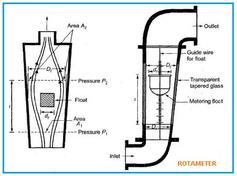Flow Measurement Methods and Instruments
Advertisement
This article explores the various methods and instruments used to measure the flow of materials in a process. The choice of method depends on several factors, including the material’s condition, flow type, volume, range, pressure, temperature, accuracy needs, and required control.
The characteristics of flow are often determined using the Reynolds number, which is a dimensionless quantity that describes whether a flow is laminar or turbulent.

Flow Measurement Methods
Here’s a breakdown of commonly used flow measurement methods:
- Variable Head Flow Meters: These meters work by creating an obstruction in the fluid path. This obstruction results in a differential pressure, which is then used to measure the fluid flow. Examples include:
- Venturimeter
- Orifice meter
- Flow nozzle
- Pitot tube
- Variable Area and Variable Head Flow Meters:
- Weirs
- Flumes
- Variable Area Type Flowmeters:
- Rotameter
- Turbine flowmeter
- Ultrasonic flowmeter
- Laser Doppler Aneamometer (LDA)
Flow Measuring Instruments
The following table outlines various flow measuring instruments and their descriptions:
| Flow Measuring Instrument | Description |
|---|---|
| Venturimeter | Used to measure discharge through a pipe, based on Bernoulli’s principle. It offers high sensitivity and can be used in any position, suitable for water, gases, liquids, and slurries. |
| Orifice meter | Measures volumetric flow rate, also working on Bernoulli’s principle. Different types of orifice plates are used to cater to various applications. |
| Flow Nozzle | Similar to a venturimeter but without a diverging zone. It uses less jet contraction than an orifice meter. |
| Pitot tube | Operates on the principle of transforming the kinetic energy of a liquid into potential energy in the form of static head. It consists of two concentric tubes. |
| Weirs | Commonly used for measuring flow in open channels or streams. Different types exist based on their notches (rectangular, V-type, trapezoidal, etc.). They find use in water works and waste/sewage systems, measuring flow from liters/minute to millions of liters/day. |
| Flumes | Sized to form an inlet and a narrower throat, resembling a venturi. Thus they’re often referred to as venturi-flumes. |
| Rotameter | A constant pressure drop type variable area flowmeter. Fluid flows from bottom to top within the meter. |
| Electromagnetic flowmeter | A non-obstruction type flowmeter, suitable for measuring the flow of slurries and electrically conductive liquids. It uses a non-conducting, non-magnetic pipe surrounded by an electromagnet, which produces a magnetic field. |
| Turbine flowmeter | A volumetric flowmeter. A small turbine wheel is placed inside the pipe, aligned with the fluid flow. |
| Ultrasonic flowmeter | Utilizes ultrasonic transducers or piezo-electric crystals to measure average velocity along the path of emitted ultrasonic waves. Crystals are placed in various arrangements within the tube. |
| Laser Doppler Aneamometer (LDA) | Employs a laser beam, which is focused at the point where flow velocity needs to be measured. |
Advertisement
 T&M
T&M 





